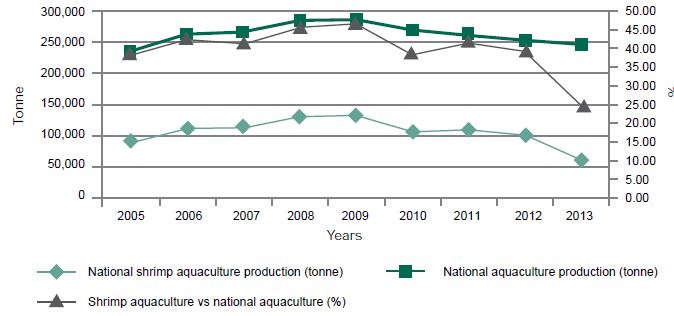1 INTRODUCTION
Aquaculture in Mexico was started towards the end of the 19th century, as a complementary activity for social support in rural communities (Juárez-Palacios, 1987).
It started with the importation of rainbow trout eggs from the United States (Arredondo, 1996). Although this activity initially evolved towards other freshwater
Figure 1. Comparison of shrimp production (shrimp aquaculture vs national aquaculture) in México.

species, during the 1980s, mariculture was started at an experimental level with species such as spotted sand bass, snapper, snook, red snapper, seabass, pompano, totoaba, and sole (Avilés, 2000).
Shrimp aquaculture was initiated during the 1970s in the northwestern Mexican states of Sonora, Sinaloa and Nayarit, in earthen ponds at low densities. This continues to be the most widely practiced culture method, covering around 70,000 hectares generally under nonregulated Aquaculture Production Units (UPAs—Spanish acronym). Nevertheless the cultivation of this species is one of the most productive and profitable aquaculture activities as shown by the national fisheries statistics (Figure 1).
The Mexican federal authorities have developed a series of effective strategies to recover and improve shrimp aquaculture production due to the continued decrease of shrimp production since 2009 caused by different factors such as diseases, environmental degradation, climate change and irregularities in UPAs, among others. The federal government, through the National Commission of Aquaculture and Fisheries (CONAPESCA—Spanish acronym), head of the productive sector, recognizes that the development of national aquaculture is key to national food security, and thus has vested public resources with the purpose of improving this primary activity through specific strategies.
Since 2008 the Secretariat of Agriculture, Livestock, Rural Development, Fisheries and Food (SAGARPA— Spanish acronym) through CONAPESCA, has implemented the National Aquaculture Management Program (PNOA—Spanish acronym) to develop and conduct the National Policy for Sustainable Fisheries and Aquaculture. The objectives of this Program are: (i) to achieve an orderly and competitive, sustainable aquaculture sector industry; and (ii) to provide public policy instruments able of regulating and managing the activity.
However, within the Mexican legal framework, CONAPESCA only has administrative powers such as issuing permits and concessions for aquaculture projects to be undertaken in federal waters (seas, dams, rivers, etc.). On the other hand, the Secretariat of the Environment and Natural Resources (SEMARNAT— Spanish acronym) is responsible for regulating inland aquaculture undertaken on land (private property, federal maritime-terrestrial zones, protected natural areas, etc.), as well as aquaculture of protected species.
This case study was carried out by the State Committee on Aquatic Health of the State of Nayarit (CESANAY—Spanish acronym) sponsored by federal resources in the study area called Pericos-Pimientillo (P-P) in Nayarit. The following activities were undertaken: (i) comprehensive literature search to develop the characterization of the area; and (ii) surveys in each aquaculture production unit, and a participatory workshop involving all stakeholders of the aquaculture sector in order to obtain reliable information for a comprehensive diagnosis. With this information, and using Geographical Information Systems, the suitability of sites for shrimp aquaculture was determined, as well as estimating the potential surface areas to undertake new aquaculture projects.
The target population was the shrimp aquaculture communities in need of regularization and administrative strengthening models. Regarding the study area, seven farming communities were identified where activities are developed by producers from 9 different towns: 163 shrimp aquaculture production units (WCU) operated by 488 producers, which generate a production estimated at around 1,600 tonnes.
Shrimp aquaculture activities in the study area created a total of 583 permanent and 1,237 temporary jobs; 481 people were direct beneficiaries and 2,290 indirect beneficiaries.
Aquaculture suitability for shrimp farming was determined in the study area. 5,368.00 hectares showed high aptitude, 3,661.00 hectares showed medium aptitude and 2,817.00 hectares present low aptitude for shrimp aquaculture. Regarding growth potential of aquaculture in the P-P study area, high aptitude was determined in 3,741.59 hectares (31.33 percent of total surface area), under current regulations.